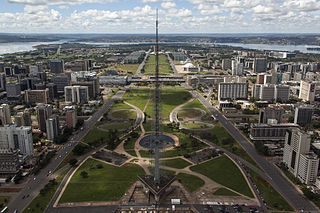
Urban design is an approach to the design of buildings and the spaces between them that focuses on specific design processes and outcomes. In addition to designing and shaping the physical features of towns, cities, and regional spaces, urban design considers 'bigger picture' issues of economic, social and environmental value and social design. The scope of a project can range from a local street or public space to an entire city and surrounding areas. Urban designers connect the fields of architecture, landscape architecture and urban planning to better organize physical space and community environments.

Landscape architecture is the design of outdoor areas, landmarks, and structures to achieve environmental, social-behavioural, or aesthetic outcomes. It involves the systematic design and general engineering of various structures for construction and human use, investigation of existing social, ecological, and soil conditions and processes in the landscape, and the design of other interventions that will produce desired outcomes.

The Torcuato Di Tella University is a non-profit private university in Buenos Aires, Argentina. Founded in 1991, the university focused primarily on social sciences.

The Bartlett Faculty of the Built Environment, also known as The Bartlett, is the academic centre for the study of the built environment at University College London (UCL), United Kingdom. It is home to thirteen departments that have expertise in individual subfields, including the Bartlett School of Architecture, Bartlett School of Planning, Bartlett Development Planning Unit, and the Centre for Advanced Spatial Analysis. The Bartlett is consistently ranked the highest in Europe and the UK and among the highest in the world for the "Architecture and the Built Environment" category in major rankings. It is currently ranked the first in the world for the year 2023.
Environmental psychology is a branch of psychology that explores the relationship between humans and the external world. It examines the way in which the natural environment and our built environments shape us as individuals. Environmental psychology emphasizes how humans change the environment and how the environment changes humans' experiences and behaviors. The field defines the term environment broadly, encompassing natural environments, social settings, built environments, learning environments, and informational environments. According to an article on APA Psychnet, environmental psychology is when a person thinks of a plan, travels to a certain place, and follows through with the plan throughout their behavior.

Christopher Charles Benninger is an Indian architect and urban planner. Born in the US, he permanently migrated to India in 1971. Benninger contributed to the field of critical regionalism and sustainable planning in India.

Steven A. Cohen is an American academic who has taught public management and environmental policy at Columbia University since 1981. He is the former executive director of Columbia University's Earth Institute and now serves as a senior advisor for the institute. He is a professor in the practice of public affairs at Columbia University's School of International and Public Affairs. He is also the director of the Master of Public Administration in Environmental Science and Policy in the School of International and Public Affairs and the director of the Master of Science in Sustainability Management in the School of Professional Studies. He served on the Environmental Protection Agency Administrator's National Advisory Council for Environmental Policy and Technology (2002–2004). He currently serves on the board of directors of Homes for the Homeless, faculty advisory committee for the Porter School of Environmental Studies at Tel Aviv University, and the admissions committee of the Lotos Club. Cohen is the lead independent director of the board of directors of the Willdan Group, Inc. Cohen also sits on the judging committee for the Yidan Prize Foundation. He served on the advisory board of the University of Minnesota's Institute on the Environment (2016-2022).
Simin Davoudi FAcSS is Professor of Environmental Policy and Planning at Newcastle University. She is Past President of the Association of European Schools of Planning (AESOP) and, as coordinator of the Planning Research Network, advised the Department of Communities and Local Government on its research priorities until 2007. Currently, she is a member of the DCLG Expert Panel on Housing market and Planning, and is expert advisor for the DG Environment of European Commission for Urban Environment.
Sauerbruch Hutton is an international agency for architecture, urban planning and design. It was founded in London in 1989 and is now based in Berlin, Germany. The practice is led by Matthias Sauerbruch, Louisa Hutton and Juan Lucas Young.
Randall Crane is an American urban planner who is professor emeritus of the UCLA Luskin School of Public Affairs, where he taught since 1999. He was associate then editor-in-chief of the Journal of the American Planning Association, chair of the executive committee and director of Undergraduate Studies of the Luskin School, associate and acting director of the UCLA Institute of Transportation Studies, and department vice chair and director of PhD studies of the urban planning department, among other cross-campus administrative appointments.

Culture 21, also known as Agenda 21 for culture, is a program for cultural governance developed in 2002–2004 and organized by United Cities and Local Governments.

Susannah Hagan, FRSA is the founding Director of R_E_D and Professor and School Research Leader at the Royal College of Art School of Architecture. She has written and lectured extensively on the theory and practice of environmental design, in particular, environmentally led urban design. Hagan's major publications include City Fights: Debates on Sustainable Cities ; Taking Shape: A New Contract between Architecture and Nature ; and Digitalia: Architecture and the Environmental, the Digital and the Avant-garde.
Soumyen Bandyopadhyay is an architect and architectural historian at Liverpool University where he was head of department and holds the Sir James Stirling Chair in Architecture. He has previously held professorial positions at the Manchester School of Architecture (MSA) and Nottingham Trent University.

Urban planning, also known as town planning, city planning, regional planning, or rural planning in specific contexts, is a technical and political process that is focused on the development and design of land use and the built environment, including air, water, and the infrastructure passing into and out of urban areas, such as transportation, communications, and distribution networks, and their accessibility. Traditionally, urban planning followed a top-down approach in master planning the physical layout of human settlements. The primary concern was the public welfare, which included considerations of efficiency, sanitation, protection and use of the environment, as well as effects of the master plans on the social and economic activities. Over time, urban planning has adopted a focus on the social and environmental bottom lines that focus on planning as a tool to improve the health and well-being of people, maintaining sustainability standards. Sustainable development was added as one of the main goals of all planning endeavors in the late 20th century when the detrimental economic and the environmental impacts of the previous models of planning had become apparent. Similarly, in the early 21st century, Jane Jacobs's writings on legal and political perspectives to emphasize the interests of residents, businesses and communities effectively influenced urban planners to take into broader consideration of resident experiences and needs while planning.

The contributions of women in climate change have received increasing attention in the early 21st century. Feedback from women and the issues faced by women have been described as "imperative" by the United Nations and "critical" by the Population Reference Bureau. A report by the World Health Organization concluded that incorporating gender-based analysis would "provide more effective climate change mitigation and adaptation."

Itala Fulvia Villa (1913–1991) was an Argentinian architect whose main forte was city planning. She was an integral part of creating and designing the urban model for the city of Buenos Aires. As part of urbanization process, she designed and built a plan for the neighborhood known as Bajo Flores, where Pope Francis grew up, for which she received first prize in the 6th National Exhibition of Architecture Fair in 1945. In 1979, she was a representative of the Argentina Federation of University Women.

Odilia Suárez was an Argentine architect, educator and urban planner. After graduating with the Gold Medal for 1950 from the University of Buenos Aires, she studied at Taliesin West with Frank Lloyd Wright and studied municipal planning in Canada, Great Britain and the United States. After returning to Argentina in 1964, she opened her own design studio at the University of Buenos Aires, working her way through the academic ranks to head the post-graduate research program in the architectural department, to finally Professor Emerita of the School of Architecture and Urbanism. At a time when few women were able to work in the field, Suárez was a pioneer and was committed to region-wide professionalism and scholarship. As an urban planner, she served as president of the City Council of Urban Planning for Buenos Aires and consulted on projects in Managua, Nicaragua and Puerto Madero. Her expertise led to a consultancy with the United Nations for planning and urban design throughout Latin America. Throughout her career, she won nineteen national architecture prizes and was one of the pillars of urban planning for Buenos Aires.

Matthew Carmona is an architect, planner and researcher based in the United Kingdom. His research focuses on the process of design governance and management of Public Space. He has taught at the University of Nottingham and The Bartlett, the latter since 1998.

Ciudad Universitaria is an urban campus of the University of Buenos Aires, the largest and most prestigious university in Argentina. Originally designed as a potential centralized campus for all of the university's facilities, nowadays it only houses two of its thirteen faculties: the Faculty of Architecture, Design and Urbanism and the Faculty of Exact and Natural Sciences, as well as a number of dependent institutes and a sports center.













